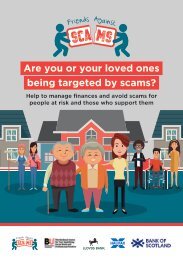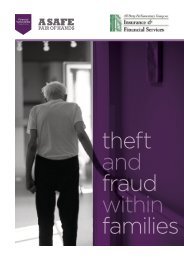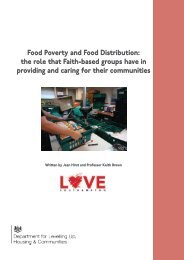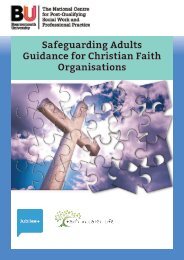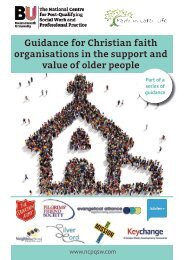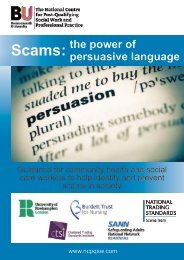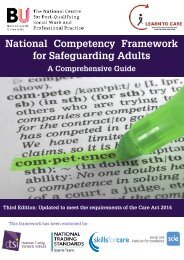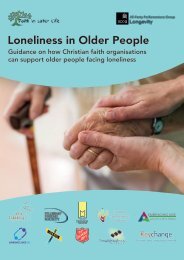0-Coercion and control report with pics FINAL
Coercion and control are used in both domestic and financial abuse. There are also differences in how agencies approach these concerns, and we seek to highlight this to learn from and utilise best practice.
Coercion and control are used in both domestic and financial abuse. There are also differences in how agencies approach these concerns, and we seek to highlight this to learn from and utilise best practice.
Create successful ePaper yourself
Turn your PDF publications into a flip-book with our unique Google optimized e-Paper software.
Successful ways of working<br />
One example of a local authority’s approach to tackling financial abuse <strong>and</strong> its associated<br />
debts is Norfolk County Council who have set up a team dedicated to making safeguarding<br />
enquiries about financial abuse. Although debt recovery is not the focus of the team,<br />
between ‘August 2019 <strong>and</strong> August 2020 there has been a financial recovery to the local<br />
authority of £154,299.80 in one off payments <strong>and</strong> £19,338.09 in monthly payments’ (Brown<br />
et al 2021:16). There are over three hundred local authorities in Engl<strong>and</strong> alone, each trying<br />
to regain misappropriated funds <strong>and</strong> each experiencing their own financial hardship<br />
because of public sector cuts. We need more best practice examples like this to be shared<br />
<strong>and</strong> data captured.<br />
Taking a strengths-based approach for financial abuse is likely to be effective.<br />
Underst<strong>and</strong>ing what increases someone’s risk of the abuse is useful - but should be used<br />
<strong>with</strong> some caution to avoid labelling people as ‘vulnerable’ as if it were a permanent state -<br />
which for many, it isn’t. If people have successfully avoided financial abuse for most of their<br />
lives, practitioners need to draw that out of them to build their self-esteem <strong>and</strong> resilience -<br />
or better still as a preventative tool when we come across the person in our day-to-day<br />
work. ‘When considering involvement in a financial fraud or scam, it is therefore important<br />
to adopt a person-centred approach that acknowledges the intersection of various factors<br />
which contribute to individual vulnerability <strong>and</strong> individual assets which may support the<br />
individual to protect themselves <strong>and</strong> prevent victimisation’ (Fenge <strong>and</strong> Lee 2018:909).<br />
Models that emphasise emotional vulnerability of victims ‘tend to ignore the protective<br />
factors that older adults use to avoid financial exploitation (Ross et al., 2014). This suggests<br />
that practitioners should explore individual strengths <strong>and</strong> assets that support individuals to<br />
safeguard themselves’ (Fenge <strong>and</strong> Lee 2018:911-12). This should include how we tackle<br />
loneliness <strong>and</strong> the perceived love/friendship between perpetrators <strong>and</strong> victims - both of<br />
which are central risk factors in financial abuse - <strong>and</strong> for adult social care this poses<br />
challenges in a resource starved world.<br />
Using a trauma-informed approach in our work <strong>with</strong> victims of financial abuse helps us to<br />
avoid re-traumatising people– for example our use of language should not belittle or shame<br />
victims <strong>and</strong> should instead reassure, encourage <strong>and</strong> empower. Trauma informed<br />
approaches help practitioners to underst<strong>and</strong> that the presenting issue may be as a result of<br />
how the victim has learnt to cope <strong>with</strong> life due to unprocessed trauma. This could be<br />
especially useful when working <strong>with</strong> repeat victims <strong>and</strong> we could again learn from selfneglect<br />
<strong>and</strong> domestic abuse best practice examples here.<br />
In best practice examples, supporting victims to build resilience happens during a<br />
safeguarding process. In reality busy workers move onto the next crisis <strong>and</strong> this aftercare<br />
doesn’t always happen. Our experiences are echoed in research: aftercare is rarely<br />
mentioned. The focus tends to be on prevention <strong>and</strong> identifying risk, <strong>with</strong> a notable lack of<br />
practical suggestions for how professionals should talk to victims <strong>and</strong> investigate financial<br />
abuse - including how to evidence it. This is despite repeated statements that the impact of<br />
financial abuse ‘is often devastating in terms of future peace of mind <strong>and</strong> health. Victims<br />
can be left <strong>with</strong> damaged self-esteem <strong>and</strong> a reduced sense of self-worth. Victims suffer<br />
stress, anxiety <strong>and</strong> depression. Lives can be ruined’ (OFT 2006:25). We know that in<br />
21





